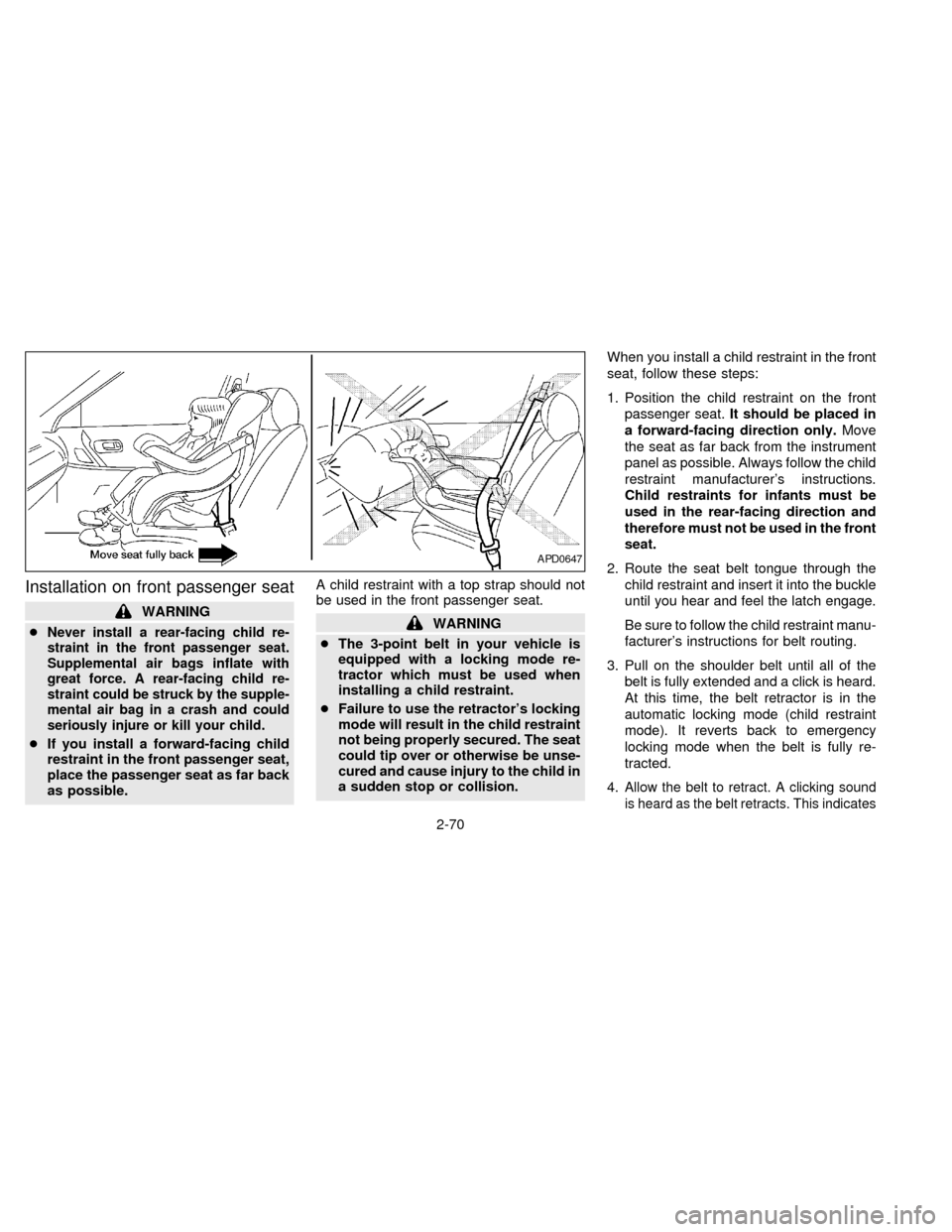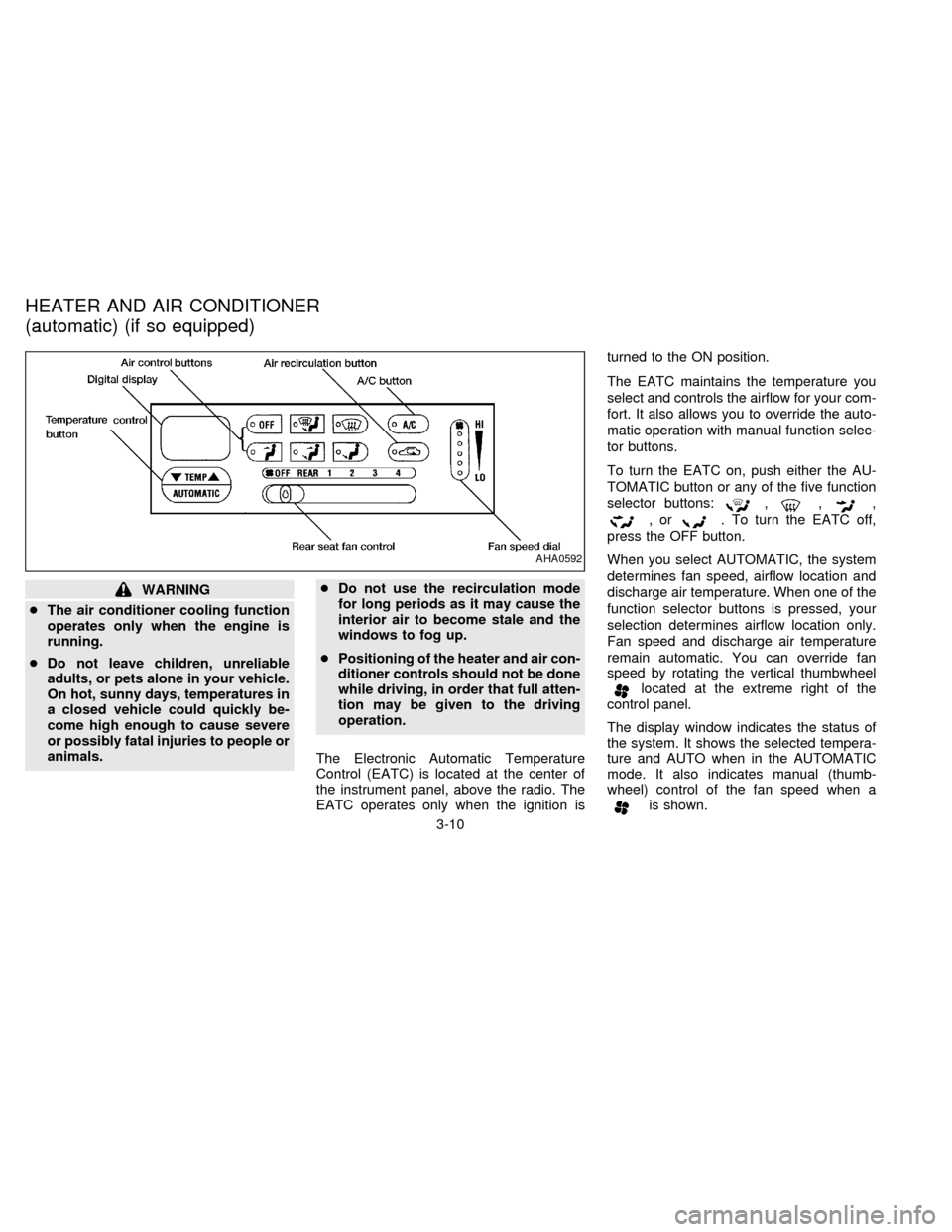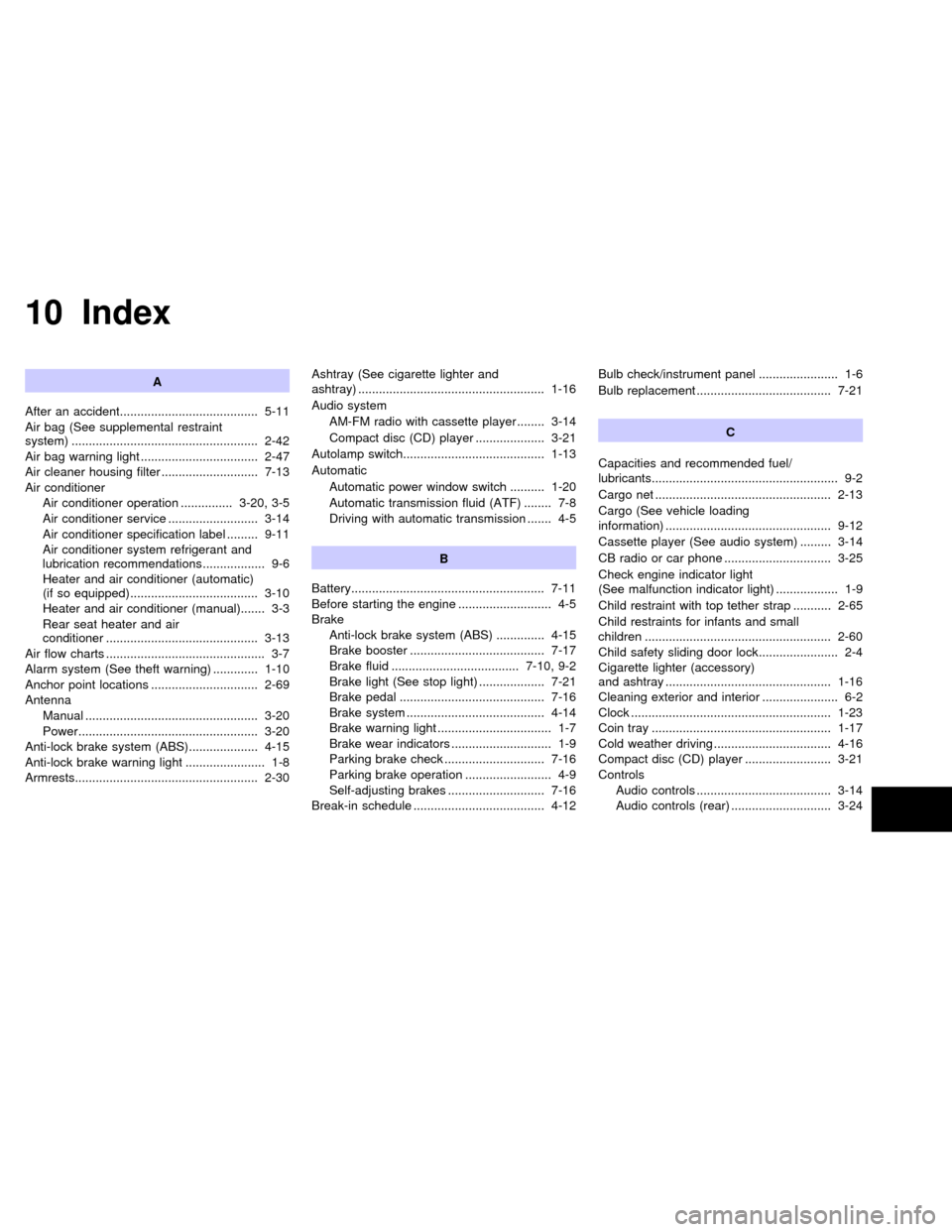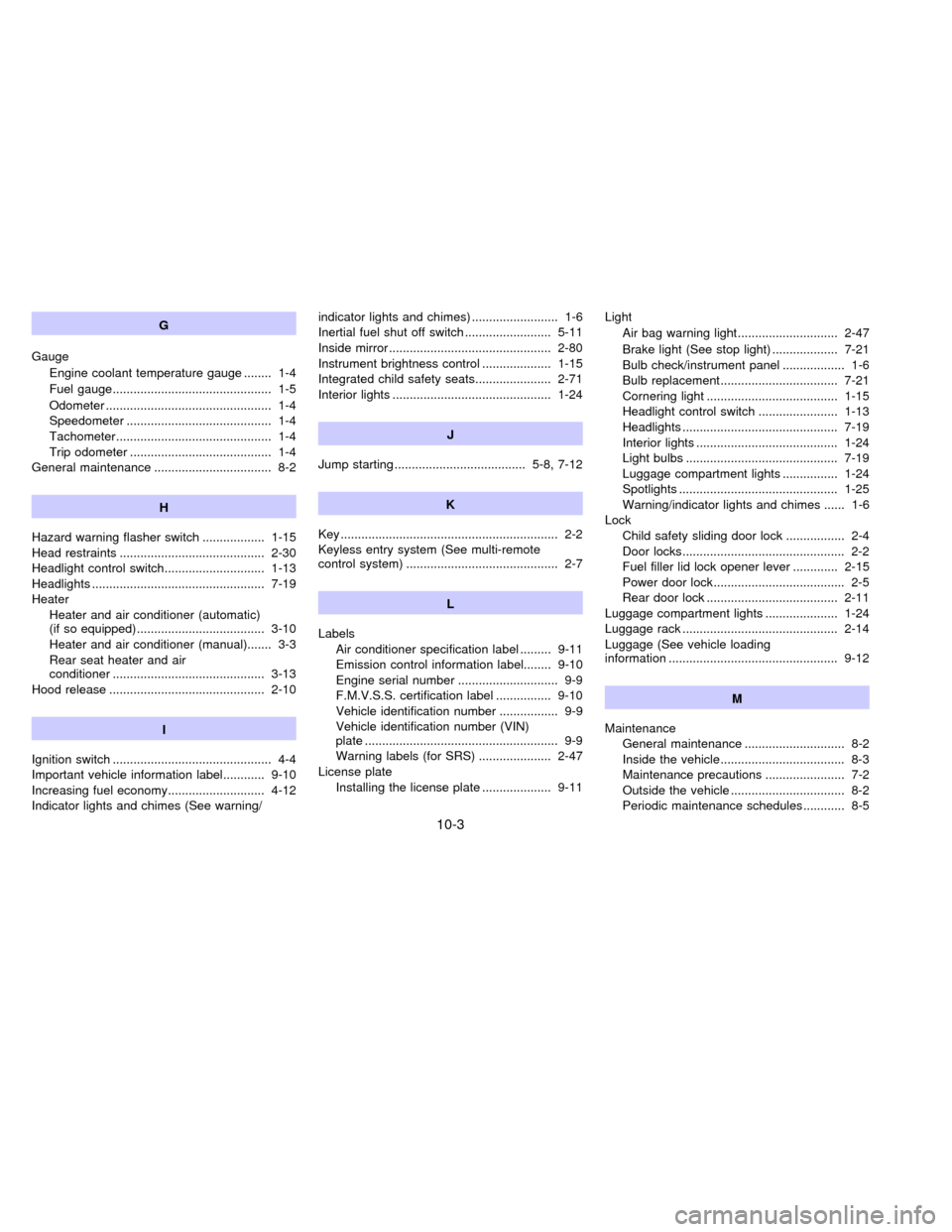1997 NISSAN QUEST instrument panel
[x] Cancel search: instrument panelPage 103 of 247

Installation on front passenger seat
WARNING
c
Never install a rear-facing child re-
straint in the front passenger seat.
Supplemental air bags inflate with
great force. A rear-facing child re-
straint could be struck by the supple-
mental air bag in a crash and could
seriously injure or kill your child.
cIf you install a forward-facing child
restraint in the front passenger seat,
place the passenger seat as far back
as possible.A child restraint with a top strap should not
be used in the front passenger seat.
WARNING
cThe 3-point belt in your vehicle is
equipped with a locking mode re-
tractor which must be used when
installing a child restraint.
cFailure to use the retractor's locking
mode will result in the child restraint
not being properly secured. The seat
could tip over or otherwise be unse-
cured and cause injury to the child in
a sudden stop or collision.When you install a child restraint in the front
seat, follow these steps:
1. Position the child restraint on the front
passenger seat.It should be placed in
a forward-facing direction only.Move
the seat as far back from the instrument
panel as possible. Always follow the child
restraint manufacturer's instructions.
Child restraints for infants must be
used in the rear-facing direction and
therefore must not be used in the front
seat.
2. Route the seat belt tongue through the
child restraint and insert it into the buckle
until you hear and feel the latch engage.
Be sure to follow the child restraint manu-
facturer's instructions for belt routing.
3. Pull on the shoulder belt until all of the
belt is fully extended and a click is heard.
At this time, the belt retractor is in the
automatic locking mode (child restraint
mode). It reverts back to emergency
locking mode when the belt is fully re-
tracted.
4.
Allow the belt to retract. A clicking sound
is heard as the belt retracts. This indicates
APD0647
2-70
ZX
Page 123 of 247

WARNING
cThe air conditioner cooling function
operates only when the engine is
running.
cDo not leave children, unreliable
adults, or pets alone in your vehicle.
On hot, sunny days, temperatures in
a closed vehicle could quickly be-
come high enough to cause severe
or possibly fatal injuries to people or
animals.cDo not use the recirculation mode
for long periods as it may cause the
interior air to become stale and the
windows to fog up.
cPositioning of the heater and air con-
ditioner controls should not be done
while driving, in order that full atten-
tion may be given to the driving
operation.
The Electronic Automatic Temperature
Control (EATC) is located at the center of
the instrument panel, above the radio. The
EATC operates only when the ignition isturned to the ON position.
The EATC maintains the temperature you
select and controls the airflow for your com-
fort. It also allows you to override the auto-
matic operation with manual function selec-
tor buttons.
To turn the EATC on, push either the AU-
TOMATIC button or any of the five function
selector buttons:
,,,
,or. To turn the EATC off,
press the OFF button.
When you select AUTOMATIC, the system
determines fan speed, airflow location and
discharge air temperature. When one of the
function selector buttons is pressed, your
selection determines airflow location only.
Fan speed and discharge air temperature
remain automatic. You can override fan
speed by rotating the vertical thumbwheel
located at the extreme right of the
control panel.
The display window indicates the status of
the system. It shows the selected tempera-
ture and AUTO when in the AUTOMATIC
mode. It also indicates manual (thumb-
wheel) control of the fan speed when a
is shown.
AHA0592
HEATER AND AIR CONDITIONER
(automatic) (if so equipped)
3-10
ZX
Page 124 of 247

AUTOMATIC OPERATION
Push the AUTOMATIC button and select
the desired temperature. The selected tem-
perature and AUTO show in the display
window. The EATC heats or cools to
achieve the set temperature.
When in AUTOMATIC and weather condi-
tions require heat, air is sent to the floor.
However, a feature is included in the EATC
to prevent blowing cold air to the floor if the
engine coolant is not warm enough to allow
heating. In three or four minutes the fan
speed gradually increases and airflow
changes to the floor.
If unique conditions exist, such as window
fogging, the five override buttons allow spe-
cific airflow selection. The thumbwheel al-
lows you to adjust the fan speed to suit your
needs.
Temperature selection
TheTEMPbutton on the left
side of the control panel is for temperature
selection. The
side lowers the set
temperature, and theside raises the
set temperature. Press and hold either side
of the button to rapidly change the tempera-
ture setting in one degree increments toeither 65ÉF (18ÉC) or 85ÉF (29ÉC). If you
want continuous maximum cooling, push
the
side of the TEMP button until
60ÉF (16ÉC) shows in the display window.
The EATC cools at maximum and disre-
gards the 60ÉF (16ÉC) setting until a warmer
temperature is selected. If you want con-
tinuous maximum heating, push the
side of the TEMP button until 90ÉF
(32ÉC) shows in the display window. The
EATC provides maximum heat regardless
of the 90ÉF (32ÉC) setting until a cooler
temperature is selected.
Fan speed and thumbwheel
Your EATC automatically adjusts the fan
speed to the existing conditions. To control
the fan speed yourself, use the thumbwheel
located at the extreme right side of the
EATC control panel. Using the thumbwheel
cancels the automatic fan speed control,
and causes a
to appear in the display
window. Rotate the thumbwheel up for HI
speeds and down for LO speeds.
To return to auto fan control, press the
AUTOMATIC button.
AIR CONTROL BUTTONS
Your EATC has five buttons which allow youto make special selections. The buttons are
grouped in the middle of the EATC panel
and allow you to determine airflow location.
Pressing any of the air control buttons
changes airflow location only, and does not
affect the ability of the system to control
temperature or fan speed. Return to fully
automatic operation by pushing the AUTO-
MATIC button.
Push this button for airflow to the floor and
windshield at the same time. Thein-
dicator light comes on, and the display
window shows the set temperature.
Press this button to obtain maximum airflow
to the windshield. Adjust the temperature
setting as required for defrosting. The
indicator light comes on, and the
display window shows the set temperature.
When the outside temperature is about
50ÉF (10ÉC) or above, the air is dehumidi-
fied to prevent window fogging.
Push this button to select airflow through
the instrument panel registers. The
indicator light comes on, and the
display window shows the set temperature.
3-11
ZX
Page 125 of 247

The EATC heats the air if the selected
temperature is warmer than the outside air
coming into the vehicle. However, the air is
not cooled regardless of the temperature
setting.
Push this button to get air from the floor and
instrument panel registers at the same time.
The
indicator light comes on and the
display window shows the set temperature.
Depending on the selected temperature, the
air is automatically heated or cooled.
Push this button to direct airflow to the floor.
Theindicator light comes on, and the
display window shows the set temperature.
The air cannot be cooled in the
mode, only heated.
AIR CONDITIONER AND AIR RE-
CIRCULATION
Activate the air conditioner in any of the
override modes listed above by pressing the
A/C button. The A/C indicator light comes
on to verify activation, and cooled air flows
from the vents. Fan speed continues to be
controlled by the EATC unless the fan
speed thumbwheel is used to override.Press the
button to choose air recir-
culation. In this mode the EATC system
recirculates the air inside the vehicle rather
than drawing air from outside. Use this
mode together with the air conditioner to
rapidly cool the inside of the vehicle, or to
dehumidify the air inside the vehicle.
ENGLISH/METRIC MODE
Switch from English to metric temperature
display by simultaneously pressing the
and A/C buttons and holding the
thumbwheel in upper position (HI) for one
second.
AHA762
3-12
ZX
Page 134 of 247

COMPACT DISC (CD) PLAYER
(if so equipped)
NOTE: Audio control features include com-
mand buttons for CD players which can be
installed as optional equipment to upgrade
the audio system. A CD player is not in-
cluded with this system, but can be pur-
chased as an option at any time. Consult
with your NISSAN dealer for feature avail-
ability.
The compact disc player consists of two
main components, the 6 CD magazine and
the CD changer. Both components are lo-cated on the center instrument panel con-
sole, below the ashtray.How to load the CD magazine
To load the magazine with CDs, first push
the
button on the CD changer to eject
the magazine, then remove the magazine
from the changer. The inside of the CD
magazine contains six shelves, one for
each CD to be loaded. Carefully slide a CD
(label side up) onto one of the shelves and
push it in. Repeat as desired, loading up to
six CDs.
CD magazine insert
Once the desired number of CDs are loaded
into the magazine, insert the magazine back
into the CD changer.
With the ignition switch OFF, the CD maga-
zine loads into the CD changer. Once the
ignition switch is turned to ACC or ON, the
audio system returns to its previous mode.
With the ignition switch in the ACC or ON
position, the CD magazine loads into the
CD changer and begins play with disc 1,
track 1.
CD player controls
BASS, TREB, BAL, AND FADE
The bass, treble, balance, and fader con-
trols for the CD player are the same as
those for the radio and cassette tape player.
Refer to the ``Adjusting tone quality'' section
for operating instructions on these controls.
CD
Push this button to switch from radio or tape
mode to CD mode. CD play begins auto-
matically if at least one disc is loaded in the
magazine. The display window shows the
AHA0597
3-21
ZX
Page 241 of 247

10 Index
A
After an accident........................................ 5-11
Air bag (See supplemental restraint
system) ...................................................... 2-42
Air bag warning light .................................. 2-47
Air cleaner housing filter ............................ 7-13
Air conditioner
Air conditioner operation ............... 3-20, 3-5
Air conditioner service .......................... 3-14
Air conditioner specification label ......... 9-11
Air conditioner system refrigerant and
lubrication recommendations.................. 9-6
Heater and air conditioner (automatic)
(if so equipped)..................................... 3-10
Heater and air conditioner (manual)....... 3-3
Rear seat heater and air
conditioner ............................................ 3-13
Air flow charts .............................................. 3-7
Alarm system (See theft warning) ............. 1-10
Anchor point locations ............................... 2-69
Antenna
Manual .................................................. 3-20
Power.................................................... 3-20
Anti-lock brake system (ABS).................... 4-15
Anti-lock brake warning light ....................... 1-8
Armrests..................................................... 2-30Ashtray (See cigarette lighter and
ashtray) ...................................................... 1-16
Audio system
AM-FM radio with cassette player ........ 3-14
Compact disc (CD) player .................... 3-21
Autolamp switch......................................... 1-13
Automatic
Automatic power window switch .......... 1-20
Automatic transmission fluid (ATF) ........ 7-8
Driving with automatic transmission ....... 4-5
B
Battery........................................................ 7-11
Before starting the engine ........................... 4-5
Brake
Anti-lock brake system (ABS) .............. 4-15
Brake booster ....................................... 7-17
Brake fluid ..................................... 7-10, 9-2
Brake light (See stop light) ................... 7-21
Brake pedal .......................................... 7-16
Brake system ........................................ 4-14
Brake warning light ................................. 1-7
Brake wear indicators ............................. 1-9
Parking brake check ............................. 7-16
Parking brake operation ......................... 4-9
Self-adjusting brakes ............................ 7-16
Break-in schedule ...................................... 4-12Bulb check/instrument panel ....................... 1-6
Bulb replacement ....................................... 7-21
C
Capacities and recommended fuel/
lubricants...................................................... 9-2
Cargo net ................................................... 2-13
Cargo (See vehicle loading
information) ................................................ 9-12
Cassette player (See audio system) ......... 3-14
CB radio or car phone ............................... 3-25
Check engine indicator light
(See malfunction indicator light) .................. 1-9
Child restraint with top tether strap ........... 2-65
Child restraints for infants and small
children ...................................................... 2-60
Child safety sliding door lock....................... 2-4
Cigarette lighter (accessory)
and ashtray ................................................ 1-16
Cleaning exterior and interior ...................... 6-2
Clock .......................................................... 1-23
Coin tray .................................................... 1-17
Cold weather driving .................................. 4-16
Compact disc (CD) player ......................... 3-21
Controls
Audio controls ....................................... 3-14
Audio controls (rear) ............................. 3-24
ZX
Page 243 of 247

G
Gauge
Engine coolant temperature gauge ........ 1-4
Fuel gauge.............................................. 1-5
Odometer ................................................ 1-4
Speedometer .......................................... 1-4
Tachometer............................................. 1-4
Trip odometer ......................................... 1-4
General maintenance .................................. 8-2
H
Hazard warning flasher switch .................. 1-15
Head restraints .......................................... 2-30
Headlight control switch............................. 1-13
Headlights .................................................. 7-19
Heater
Heater and air conditioner (automatic)
(if so equipped)..................................... 3-10
Heater and air conditioner (manual)....... 3-3
Rear seat heater and air
conditioner ............................................ 3-13
Hood release ............................................. 2-10
I
Ignition switch .............................................. 4-4
Important vehicle information label............ 9-10
Increasing fuel economy............................ 4-12
Indicator lights and chimes (See warning/indicator lights and chimes) ......................... 1-6
Inertial fuel shut off switch ......................... 5-11
Inside mirror ............................................... 2-80
Instrument brightness control .................... 1-15
Integrated child safety seats...................... 2-71
Interior lights .............................................. 1-24
J
Jump starting ...................................... 5-8, 7-12
K
Key ............................................................... 2-2
Keyless entry system (See multi-remote
control system) ............................................ 2-7
L
Labels
Air conditioner specification label ......... 9-11
Emission control information label........ 9-10
Engine serial number ............................. 9-9
F.M.V.S.S. certification label ................ 9-10
Vehicle identification number ................. 9-9
Vehicle identification number (VIN)
plate ........................................................ 9-9
Warning labels (for SRS) ..................... 2-47
License plate
Installing the license plate .................... 9-11Light
Air bag warning light............................. 2-47
Brake light (See stop light) ................... 7-21
Bulb check/instrument panel .................. 1-6
Bulb replacement.................................. 7-21
Cornering light ...................................... 1-15
Headlight control switch ....................... 1-13
Headlights ............................................. 7-19
Interior lights ......................................... 1-24
Light bulbs ............................................ 7-19
Luggage compartment lights ................ 1-24
Spotlights .............................................. 1-25
Warning/indicator lights and chimes ...... 1-6
Lock
Child safety sliding door lock ................. 2-4
Door locks............................................... 2-2
Fuel filler lid lock opener lever ............. 2-15
Power door lock...................................... 2-5
Rear door lock ...................................... 2-11
Luggage compartment lights ..................... 1-24
Luggage rack ............................................. 2-14
Luggage (See vehicle loading
information ................................................. 9-12
M
Maintenance
General maintenance ............................. 8-2
Inside the vehicle.................................... 8-3
Maintenance precautions ....................... 7-2
Outside the vehicle ................................. 8-2
Periodic maintenance schedules ............ 8-5
10-3
ZX